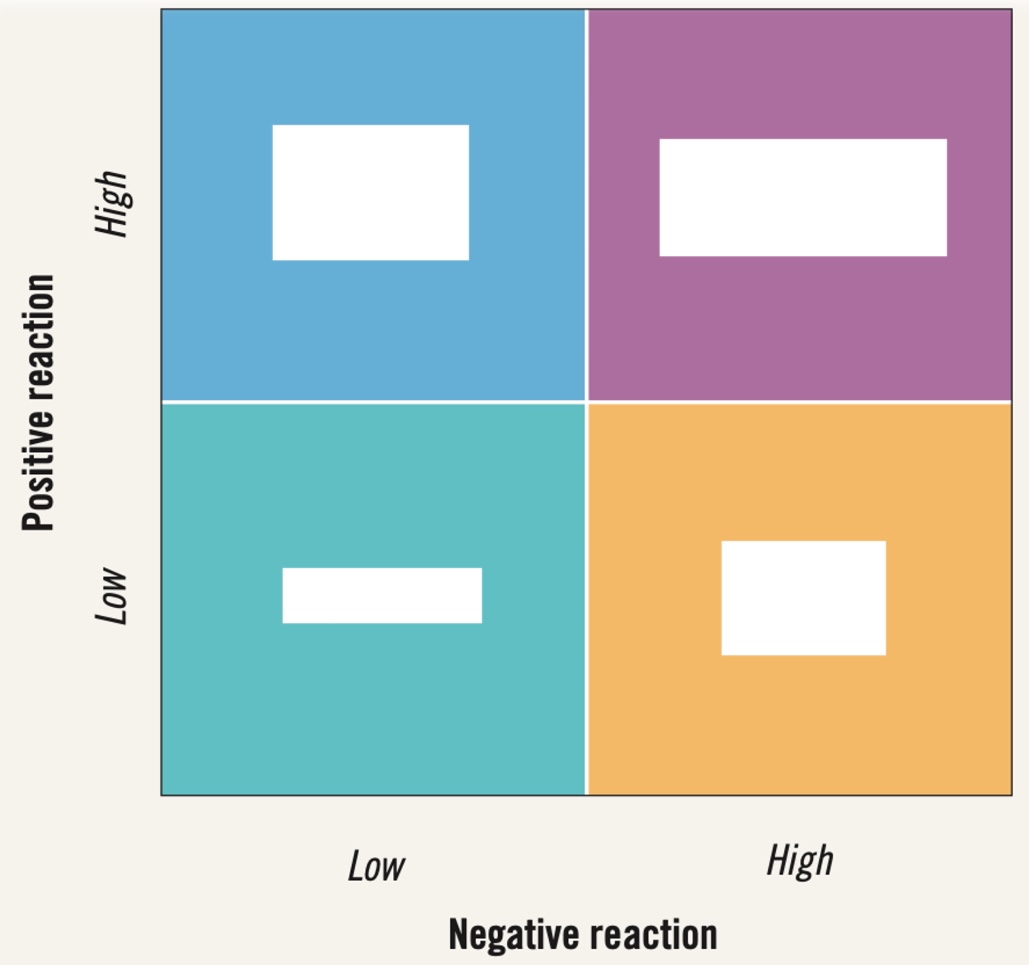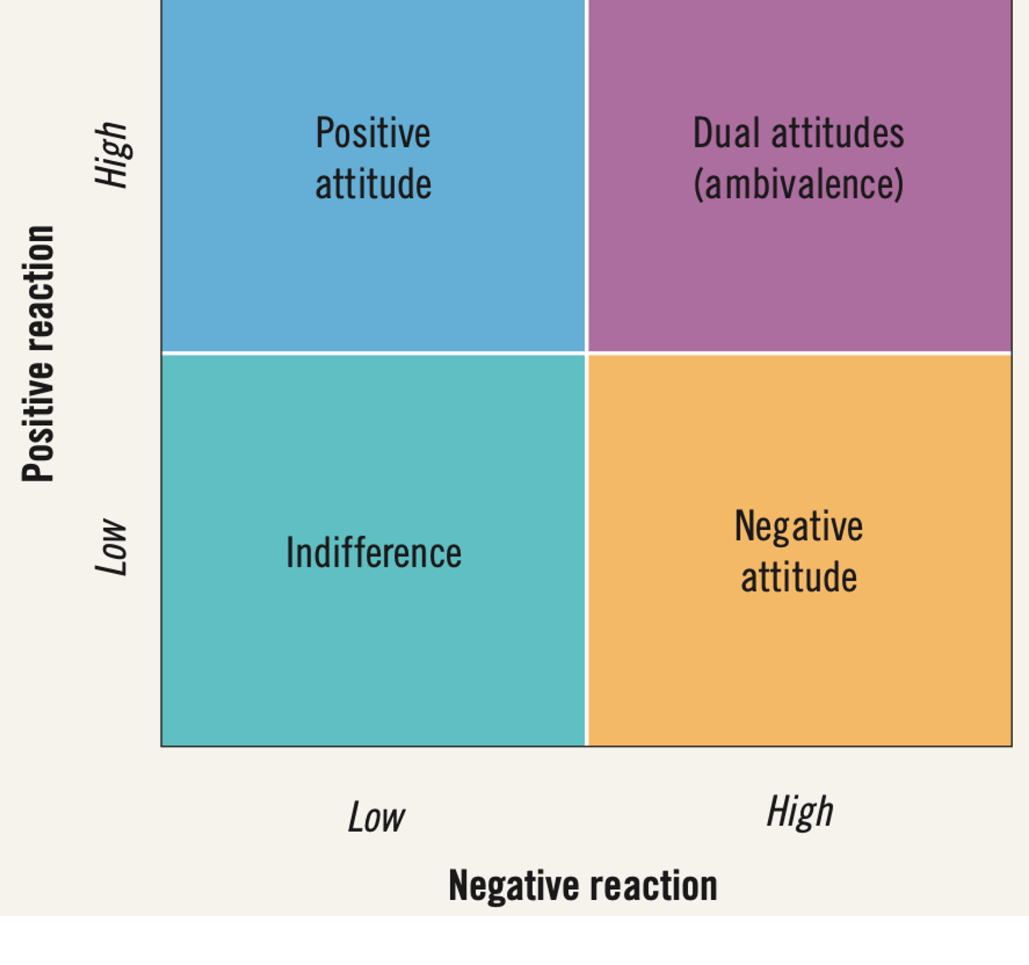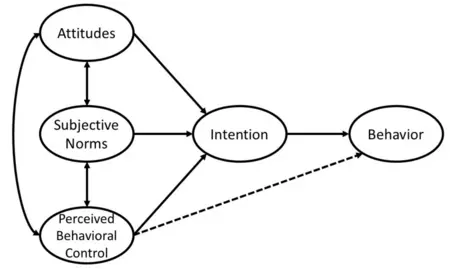5 Attitudes and Persuasion
1/12
There's no tags or description
Looks like no tags are added yet.
Name | Mastery | Learn | Test | Matching | Spaced |
|---|
No study sessions yet.
13 Terms
People ______ and _______ to persons, objects, places, ideas, issues, and events in their life. The value judgements made everyday are called _________
Evaluate and react
Attitudes

What does this model illustrate about attitudes?
not a single continuum
not bipolar, more complex
fluidity - not fixed, dynamic (some attitudes may be stable over time, others change dramatically)

Does forming judgement serve any useful purpose? Any downsides?
Social functions, means of self expression, express/signal affiliation (group membership and identity), social interactions
Conflict, potential to become bias & prejudice, heuristics, result in being close minded and ignore other sources of information
How are attitudes measured? (4 ans)
self report measures of attitude ⇒ using list of statements and scale of agree/disagree (cannot always ensure true opinions are expressed)
non-verbal measures of attitude ⇒ facial expressions, tone, body language, & involuntary physical reactions examined. facial electromyography (EMG) used to detect minuscule muscular changes
neural activity ⇒ electroencephalograph (EEG) to examine brain waves, fMRI to examine brain activity in regions (e.g. areas associated with emotions like amygdala)
implicit association test (IAT) ⇒ unconscious attitudes that cannot be self reported due to lack of awareness, useful for predicting socially sensitive topics where people conceal opinions
Do attitudes and behaviours always go hand in hand?
not always
there could be a lack of correspondence between attitudes and behaviour
Which model illustrates how attitudes can influence behaviour (decision making)?
Theory of planned behaviour (Ajzen)
there can often be conflict between 3 factors, in which there is a hierarchy of priority

How can attitudes be changed? What factors influence how effective it is?
Persuasion (process by which attitudes are changed)
3 components: source (who), message (what, context), audience (to whom)

What are the two processing strategies (routes) on taking in information? What determines which route is taken?
Dual-Process Model (Petty and Cacioppo)
central route (rational) vs peripheral route (shortcut) depends on whether one is willing and able to scrutinise information of message
central route ⇒ audience is motivated & analytical, willing to put in high cognitive effort to evaluate message, has lasting change in attitude & strength in change
peripheral route ⇒ audience is not motivated, putting in low effort, persuaded by cues other than message, temporary and weak change in attitude

What two factors influence the effectiveness of persuasion from its source?
credibility ⇒ competence/trustworthiness, expertise, stereotypes, whether person has something to gain from persuasion
likability and similarity ⇒ being liked & persuasive go hand in hand, celebrity endorsements, physical attractiveness, similarity and frequent exposure increases familiarity, dissimilarity can have inhibiting effect
What five elements should be taken into account when considering the message itself (content and context)?
(message ⇒ medium, content - what is said, context - how it’s said)
message length ⇒ central route (length = double edged sword, length may dilute quality, need to address actual content) vs peripheral route (lengthy = valid)
message order ⇒ primacy (first impression) vs recency (memory fades, people recall most recent info) effect
how much time separated two messages, how much time elapsed bw second message and decision making period
contents of a message ⇒ depends on level of involvement/personal relevance
message discrepancy ⇒ people are motivated to defend opinions/attitudes, some discrepancy needed to produce change in attitude, too much discrepancy results in strong resistance - most change at moderate levels of discrepancy
influence of subliminal messages ⇒ hidden messages outside of conscious awareness
What factors of the audience are taken into consideration? (5 ans)
recipient’s emotions ⇒ fear based appeals, appeals when recipient is in a good mood (peripheral route taken - agreeability, maintain relations, intentions seen as positive, safety)
personality and expectations
need for cognition ⇒ high/low, customise message to adapt
self-monitoring ⇒ high (image oriented) vs low (info oriented) - responsiveness to messages about social images
regulatory fit ⇒ more likely to be influenced by message that fit frame of mind (e.g. promotion oriented vs prevention oriented)
forewarning ⇒ when aware of intent to change attitude, more likely to resist (psychological reactance) - audience likely to create counter arguments which ↑ resistance/defensiveness
How are attitudes formed? (5 ans)
inherited (genetic) ⇒ attitudes of MZ twins shown to be more similar than DZ twins
learned (env, social) ⇒ exposure to attitude, history of rewards and punishment, attitude of peers, sociocultural context
fake it till you make it ⇒ action determine feelings, role-playing change in attitude
self generated persuasion ⇒ attitude change through generating arguments themselves (e.g. convincing self to like something)
cognitive dissonance theory
What is meant by cognitive dissonance and how does it relate to changes in attitudes?
cognitive dissonance ⇒ desire for cognitive consistency (beliefs, attitudes, behaviours are compatible)
inconsistencies can arouse psychological tension that people are motivated to reduce
attitude-discrepant behaviours are justified through changes in thought process/attitude